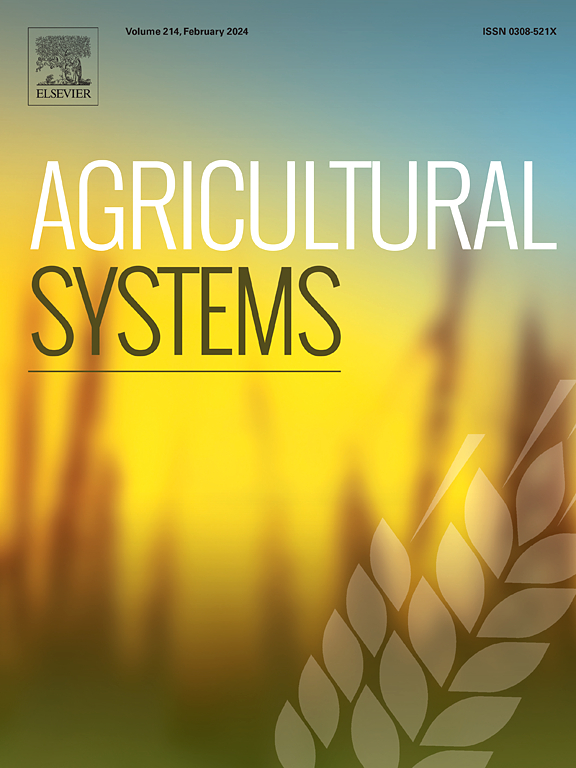Comprehensive assessment of the agronomic, environmental and economic benefits of localized fertilizer placement in China's intensive cereal production systems
IF 6.1
1区 农林科学
Q1 AGRICULTURE, MULTIDISCIPLINARY
引用次数: 0
Abstract
Context
The current ‘high input-high output’ nutrient management model based on homogeneous spread across the soil surface remains a key challenge in China's farming systems, resulting in diminished fertilizer use efficiency and increased environmental pollution. Localized placement of fertilizers (LPF) in the root zones of the crop has been proposed as a viable and practical approach to improve crop yield and ecological quality.
Objective
In this study, the impact of LPF on cereal productivity (wheat, rice, and maize), cumulative emissions of ammonia (NH3) and nitrous oxide (N2O), and economic benefits was evaluated, and the influence of management, climate and soil factors on response ratio was elucidated.
Methods
A meta-analysis approach was adopted (encompassing 85 field studies published between 2002 and 2023), and a random effects model was employed to assess the impact of LPF under various site-specific covariates. Furthermore, the findings of the meta-analysis were corroborated by field experiments across different provinces of China.
Results and conclusions
The meta-analysis revealed that LPF significantly improved the yields of the selected crops (13.62 %) and nitrogen recovery efficiency (REN) (33.09 %), while simultaneously reducing N2O (17.37 %) and NH3 emissions (60.14 %) compared to conventional surface application of fertilizers (CSA). Higher grain yield and REN were achieved at an optimal fertilization depth (FD) of 5–15 cm, while greater reductions in gaseous emissions were observed at depths exceeding 15 cm. Field validation experiments showed that the localized application of N without topdressing increased the yields of maize (6.21 %), rice (34.63 %) and wheat (2.92 %) and the net economic benefits (26.01 %) compared to CSA. Thus, LPF could be an important fertilizer management strategy to address the trifecta of food security, environmental quality, and economic gains.
Significance
Our results provide novel insights and technical support in determining optimal FD and identifying several site-specific covariates affecting the efficacy of LPF. It suggests avenues for further action research and collaborations among agricultural scientists and product designers on the development of farmer-friendly fertilizer applicators and appropriate fertilizer products.

中国集约化谷物生产系统中局部施肥的农艺、环境和经济效益综合评价
当前基于土壤表面均匀分布的“高投入高产出”养分管理模式仍然是中国农业系统面临的一个关键挑战,导致肥料利用效率下降和环境污染加剧。作物根区局部施肥是提高作物产量和生态品质的一种可行可行的方法。目的评价低通量土壤对小麦、水稻和玉米产量、氨(NH3)和氧化亚氮(N2O)累积排放和经济效益的影响,并分析管理、气候和土壤等因素对响应比的影响。方法采用荟萃分析方法(包括2002年至2023年间发表的85项实地研究),并采用随机效应模型评估不同地点特定协变量下LPF的影响。此外,meta分析的结果在中国不同省份的实地实验中得到了证实。结果与结论荟萃分析显示,与常规的地表施肥相比,低磷化肥显著提高了所选作物的产量(13.62%)和氮素回收效率(REN)(33.09%),同时减少了N2O(17.37%)和NH3排放(60.14%)。在5 ~ 15 cm的最佳施肥深度(FD)下,籽粒产量和REN均较高,而在超过15 cm的施肥深度下,气体排放量减少幅度较大。田间验证试验结果表明,局部施氮不追肥比玉米增产6.21%,水稻增产34.63%,小麦增产2.92%,净经济效益提高26.01%。因此,LPF可以成为解决粮食安全、环境质量和经济收益三重问题的重要肥料管理策略。我们的研究结果为确定最佳FD和确定影响LPF疗效的几个位点特异性协变量提供了新的见解和技术支持。它为农业科学家和产品设计者在开发农民友好型施肥机和适当的肥料产品方面进一步开展行动研究和合作提供了途径。
本文章由计算机程序翻译,如有差异,请以英文原文为准。
求助全文
约1分钟内获得全文
求助全文
来源期刊

Agricultural Systems
农林科学-农业综合
CiteScore
13.30
自引率
7.60%
发文量
174
审稿时长
30 days
期刊介绍:
Agricultural Systems is an international journal that deals with interactions - among the components of agricultural systems, among hierarchical levels of agricultural systems, between agricultural and other land use systems, and between agricultural systems and their natural, social and economic environments.
The scope includes the development and application of systems analysis methodologies in the following areas:
Systems approaches in the sustainable intensification of agriculture; pathways for sustainable intensification; crop-livestock integration; farm-level resource allocation; quantification of benefits and trade-offs at farm to landscape levels; integrative, participatory and dynamic modelling approaches for qualitative and quantitative assessments of agricultural systems and decision making;
The interactions between agricultural and non-agricultural landscapes; the multiple services of agricultural systems; food security and the environment;
Global change and adaptation science; transformational adaptations as driven by changes in climate, policy, values and attitudes influencing the design of farming systems;
Development and application of farming systems design tools and methods for impact, scenario and case study analysis; managing the complexities of dynamic agricultural systems; innovation systems and multi stakeholder arrangements that support or promote change and (or) inform policy decisions.
 求助内容:
求助内容: 应助结果提醒方式:
应助结果提醒方式:


